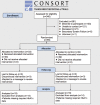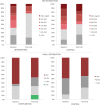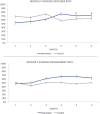Improving HbA1c with Glucose Self-Monitoring in Diabetic Patients with EpxDiabetes, a Phone Call and Text Message-Based Telemedicine Platform: A Randomized Controlled Trial
- PMID: 31621523
- PMCID: PMC7301318
- DOI: 10.1089/tmj.2019.0035
Improving HbA1c with Glucose Self-Monitoring in Diabetic Patients with EpxDiabetes, a Phone Call and Text Message-Based Telemedicine Platform: A Randomized Controlled Trial
Abstract
Background:We conducted a randomized controlled trial of EpxDiabetes, a novel digital health intervention as an adjunct therapy to reduce HbA1c and fasting blood glucose (FBG) among patients with type 2 diabetes mellitus (T2DM). In addition, we examined the effect of social determinants of health on our system.Methods:Sixty-five (n = 65) patients were randomized at a primary care clinic. Self-reported FBG data were collected by EpxDiabetes automated phone calls or text messages. Only intervention group responses were shared with providers, facilitating follow-up and bidirectional communication. ΔHbA1c and ΔFBG were analyzed after 6 months.Results:There was an absolute HbA1c reduction of 0.69% in the intervention group (95% confidence interval [CI], -1.41 to 0.02) and an absolute reduction of 0.03% in the control group (95% CI, -0.88 to 0.82). For those with baseline HbA1c >8%, HbA1c decreased significantly by 1.17% in the intervention group (95% CI, -1.90 to -0.44), and decreased by 0.02% in the control group (95% CI, -0.99 to 0.94). FBG decreased in the intervention group by 21.6 mg/dL (95% CI, -37.56 to -5.639), and increased 13.0 mg/dL in the control group (95% CI, -47.67 to 73.69). Engagement (proportion responding to ≥25% of texts or calls over 4 weeks) was 58% for the intervention group (95% CI, 0.373-0.627) and 48% for the control group (95% CI, 0.296-0.621). Smoking, number of comorbidities, and response rate were significant predictors of ΔHbA1c.Conclusions:EpxDiabetes helps to reduce HbA1c in patients with uncontrolled T2DM and fosters patient-provider communication; it has definite merit as an adjunct therapy in diabetes management. Future work will focus on improving the acceptability of the system and implementation on a larger scale trial.
Keywords: diabetes; digital health; e-health; glycemic control; self-monitoring; telemedicine.
Conflict of interest statement
No competing financial interests exist.
Figures





References
-
- CDC diabetes. Available at www.cdc.gov/diabetes/pdfs/data/statistics/national-diabetes-statistics-r... (last accessed November30, 2017)
-
- Koro CE, Bowlin SJ, Bourgeois N, Fedder DO. Glycemic control from 1988 to 2000 among U.S. adults diagnosed with type 2 diabetes: A preliminary report. Diabetes Care 2004;27:17–20 - PubMed
-
- Ali MK, Bullard KM, Saaddine JB, Cowie CC, Imperatore G, Gregg EW. Achievement of Goals in U.S. Diabetes Care, 1999–2010. N Engl J Med 2013;368:1613–1624 - PubMed
-
- Vincze G, Barner JC, Lopez D. Factors associated with adherence to self-monitoring of blood glucose among persons with diabetes. Diabetes Educ 2004;30:112–125 - PubMed
Publication types
MeSH terms
Substances
Grants and funding
LinkOut - more resources
Full Text Sources
Medical
Miscellaneous

